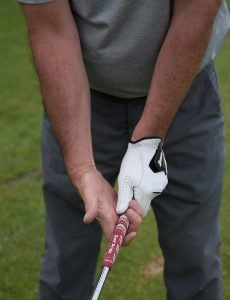Shanking the golf ball can be one of the most frustrating experiences for a golfer. It happens when the ball hits the hosel of the club, sending it off in a completely unintended direction. However, with a few simple adjustments, you can eliminate this problem and improve your game. Here are some tips on how to stop shanking the golf ball:
- Check your setup: The first thing you need to do is check your setup. Make sure your feet, hips, and shoulders are aligned properly. If your stance is too narrow or too wide, it can affect your balance, making it more difficult to hit the ball in the sweet spot. Ensure that your weight is evenly distributed on both feet.
- Adjust your grip: Your grip can also play a significant role in shanking the ball. A grip that’s too strong can cause you to hit the ball with the heel of the club, resulting in a shank. Try loosening your grip slightly to prevent this from happening.
- Keep your head steady: During your swing, it’s important to keep your head still. Moving your head up and down or side to side can cause your swing to be off-balance, leading to shanking the ball. Focus on keeping your head in one place throughout your swing.
- Practice with a towel or headcover: One effective way to stop shanking the ball is to practice hitting with a towel or headcover placed just outside the ball. This helps to prevent you from hitting the ball too far on the inside, which can lead to a shank.
- Focus on your ball position: The position of the ball in your stance can also affect your swing. If you’re consistently shanking the ball, try moving the ball slightly back in your stance. This can help you hit the ball more in the center of the clubface.
- Take lessons: If you’ve tried all of these adjustments and still can’t seem to stop shanking the ball, consider taking lessons from a golf professional. They can help you identify the root cause of your problem and provide you with specific drills to improve your swing.
- Use a shorter backswing: An overly long backswing can lead to shanking the ball. Try shortening your backswing and focusing on a smoother, more controlled swing. This can help you hit the ball in the center of the clubface and avoid hitting the hosel.
- Slow down your swing: Another common cause of shanking the ball is swinging too quickly. Try slowing down your swing and focusing on a smooth, fluid motion. This can help you maintain better control over the clubhead and hit the ball more consistently.
- Use a different club: If you’re consistently shanking the ball with a particular club, try switching to a different one. Sometimes a different club can provide a better feel and help you hit the ball more consistently.
- Relax and stay focused: Finally, it’s important to stay relaxed and focused during your swing. Shanking the ball can be a frustrating experience, but getting frustrated or tense will only make it worse. Take a deep breath, relax your muscles, and stay focused on the shot at hand.
- Practice with a mirror: Practicing in front of a mirror can help you identify flaws in your swing that may be causing you to shank the ball. Set up a mirror next to you and take a few practice swings, paying close attention to your body position, head movement, and swing path. This can help you make the necessary adjustments to improve your swing and avoid shanking the ball.
- Visualize your shots: Visualization is a powerful tool that can help you improve your golf game. Before each shot, take a moment to visualize the ball flying straight and true towards your target. This can help you focus your mind and body and make a more controlled, accurate swing.
- Get in better shape: Being physically fit and flexible can help you avoid shanking the ball. Regular exercise and stretching can improve your balance, coordination, and range of motion, making it easier to maintain a proper swing and hit the ball in the sweet spot.
- Play more often: Like any skill, golf requires practice to improve. The more often you play, the more comfortable you will become with your swing and the less likely you will be to shank the ball. Try to play as often as possible, even if it’s just a few holes after work or on the weekends.
- Don’t be too hard on yourself: Finally, it’s important to remember that golf is a challenging game, and shanking the ball is a common problem that even the best golfers experience from time to time. Don’t be too hard on yourself if you shank a shot or two – just focus on making the necessary adjustments and enjoy the game.
In conclusion, shanking the golf ball can be a frustrating and discouraging experience, but with practice and patience, you can overcome this problem and improve your game. By making adjustments to your setup, grip, swing, and mindset, practicing with a mirror, visualizing your shots, getting in better shape, playing more often, and maintaining a positive attitude, you can become a better golfer and enjoy the game even more.
Common Causes of Shanking in Golf
| Cause | Description | Correction | Drill | Example |
|---|---|---|---|---|
| Open club face | Club face is pointing right, towards the target | Square the clubface at address and impact | Place an object such as a tee on the toe of the club | Hitting a shank from the fairway or rough |
| Early release | Hands and wrists release the club too soon | Delay the release of the club | Practice making half swings | Shank on full swings |
| Over the top | Downswing path is too steep and outside-in | Swing on a more inside-out path | Place a ball or tee outside the target line | Shank off the tee or with short irons |
| Standing too close to the ball | Address position is too close to the ball | Move away from the ball at address | Take a step back from the ball at address | Shank on short irons |
| Tension in grip and arms | Grip and arms are tense and rigid during the swing | Relax the grip and arms | Practice swinging with a lighter grip | Shank with all clubs |
Recommended Drills to Stop Shanking in Golf
| Drill | Description | Benefit | Example |
|---|---|---|---|
| Towel drill | Place a towel under your arms to restrict arm movement | Promotes a more compact and controlled swing | Helps prevent early release and over the top swing |
| Alignment stick drill | Place an alignment stick outside your target line | Helps you swing on an inside-out path | Helps prevent over the top swing |
| Impact bag drill | Strike an impact bag with a mid-iron | Helps promote a proper impact position | Helps prevent shanking and fat shots |
| 3 o’clock/9 o’clock drill | Swing the club to the 3 o’clock and 9 o’clock positions | Helps promote a more compact and controlled swing | Helps prevent shanking on short shots |
| Gate drill | Place two tees outside your target line | Helps promote a proper swing path | Helps prevent over the top swing |
Common Mistakes to Avoid when Trying to Stop Shanking in Golf
| Mistake | Description | Consequence | Solution |
|---|---|---|---|
| Focusing too much on the shank | Constantly thinking about the shank can create anxiety | Leads to tension and inconsistent swings | Focus on the process and not the result |
| Trying to fix the shank mid-round | Trying to make swing changes during a round can be difficult | Can lead to further frustration and poor play | Focus on the fix during practice |
| Not practicing enough | Trying to fix a problem without proper practice can be ineffective | Leads to slow progress and inconsistent play | Make time for dedicated practice sessions |
| Overthinking | Analyzing too many swing thoughts can be overwhelming | Can lead to poor swing mechanics and inconsistent play | Focus on one or two swing thoughts |
| Not seeking professional help | Some swing faults require professional guidance | May lead to further frustration and poor play | Seek out a qualified instructor |
Equipment Adjustments to Stop Shanking in Golf
| Adjustment | Description | Benefit | Example |
|---|---|---|---|
| Club fitting | Ensuring that your clubs are properly fit to your swing | Helps promote consistent ball striking | Get fitted for the correct shaft and clubhead combination |
| Grip size | Adjusting the size of your grip to fit your hands | Helps promote a comfortable and secure grip | Experiment with different grip sizes to find the right fit |
| Club weighting | Adjusting the weight distribution of your clubs | Helps promote a more consistent swing path | Add lead tape to adjust the club’s weight distribution |
| Loft and lie adjustments | Adjusting the angle of your clubface and shaft | Helps promote consistent ball flight | Get your clubs checked and adjusted by a professional |
| Ball choice | Choosing a ball that suits your swing and playing style | Helps promote consistent ball flight | Experiment with different ball types and find one that works for you |


